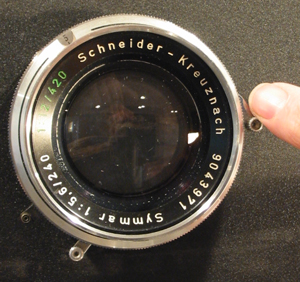Sequence viewing > Index - Cameras - lenses - optics - Resource - ©
Lloyd Godman
Film - Digital
Lenses for view cameras come in many shapes, sizes and focal lengths. Some are designed to be used on view cameras of various sizes, while others are limited to only one format.
The accompanying chart shows the comparable lens focal lengths for different film sizes. |

|
| Camera Format |
35mm |
6x7cm |
4"X5" |
8"x10" |
|
| Wide Angle Lenses |
|
|
|
125mm |
92 degrees |
|
20mm |
47mm |
65mm |
|
81-84 degrees |
|
24mm |
58mm |
75mm |
165mm |
74-79 degrees |
|
28mm |
65mm |
90mm |
180mm |
65-68 degrees |
|
|
|
105mm |
210mm (8") |
61-62 degrees |
|
35mm |
75mm |
125mm |
250mm (10") |
53-55 degrees |
| Normal Lenses |
|
|
135mm |
|
48-51degrees |
|
50mm |
90mm |
150mm(6") |
300mm (12") |
40-44degrees |
|
|
100mm |
180mm (7") |
375mm (15") |
37-38 degrees |
| Long or telephoto Lenses |
|
135mm |
210mm (8") |
450mm (18") |
31-35 degrees |
|
85mm |
150mm |
240mm (9") |
480mm (19") |
24-29 degrees |
|
105mm |
210mm |
300mm (12") |
600mm (24") |
19-22 degrees |
|
|
|
375mm (15") |
750nmm (30") |
18 degrees |
|
135mm |
250mm |
450mm |
|
15 degrees |
OPTICAL PRINCIPLES & SMALLER APERTURES
We already know light travels in a straight line and is bent by the lens to enable the image to be focused at the film plane. View camera lenses are similar to all other lenses and the three principals that relate to effect on depth-of-field also apply.
Focal length
Subject distance
Aperture setting
It is worth remembering that the depth of field decreases with the increase in focal length and a standard lens for a 35mm camera (50mm) would have a far greater depth of field than the standard lens for a 4"X5" camera (150mm lens) or a 8"x10" camera (300mm). As the focus for the larger format becomes much more critical view camera lenses often stop down further to allow more depth of field. So where as a lens for a 35mm camera might have its smallest aperture at f16 or f22 many view camera lens stop down to f45 or f64. Some even stop down for f90 or f128. When exposing the film with such small apertures it will mean using much longer shutter speeds but it will give more depth of field when using these smaller apertures.
Want to learn more? - do a workshop or one on one with Lloyd Godman
|